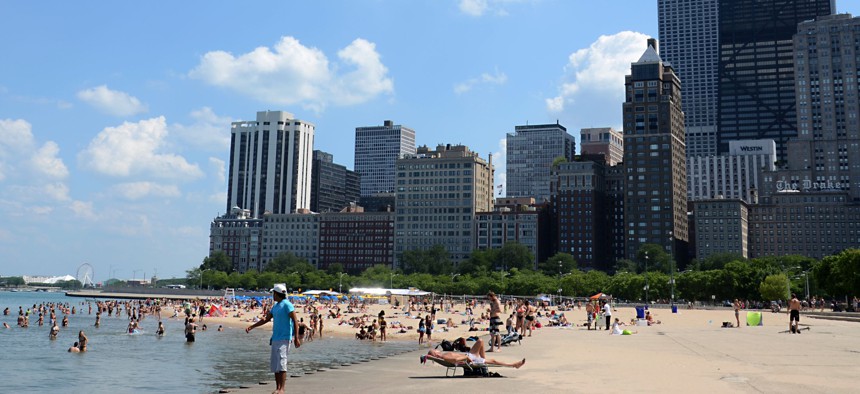Chicago’s New Civic Tech Collaboration: Better E. Coli Risk Predictions

Oak Street Beach along Chicago's Lake Michigan waterfront. Shutterstock

Connecting state and local government leaders
Volunteers are helping the Chicago Park District figure out whether there are better analytics models for water contamination hazards at Lake Michigan beaches.
Volunteers in Chicago’s civic technology community have in recent months developed predictive analytics models, which are meant to improve decisions about when beaches in the city should be closed due to high E. coli bacteria levels in Lake Michigan.
This summer, the Chicago Park District plans to test the models, with the possibility of adopting them on a permanent basis in the future if they prove to be effective. The district is responsible for managing the city’s 27 beaches, which see millions of visitors each year.
Volunteers affiliated with Chi Hack Night, a weekly event in the city focused on civic technology issues, developed the models. Late last year, Chicago’s chief data officer, Tom Schenk Jr., helped get a Hack Night workgroup started that zeroed-in on the issue of beach water quality.
Schenk pointed out in a phone interview last week that “it’s actually a very tough problem to predict the growth of bacteria in such a large body of water.”
“We had to really start using more robust and tougher statistical models,” he said.
Water sample testing offers a reliable way to make decisions about when to close beaches because of E. coli levels. But it can take up to 18 hours to get lab results for traditional water sample tests, and even getting “rapid” test results can take at least four hours.
A highly accurate predictive model could eliminate the need for that lag time, allowing officials to make quicker decisions about when to close or reopen a beach.
Such models incorporate statistical methods, and variables like weather, water conditions, and the history of E. coli at a beach, to predict the likelihood high levels of the bacteria will occur.
The Park District has used these types of models since 2012 to help determine when city beaches should be closed. But Cathy Breitenbach, the district’s director of cultural and natural resources, said by phone on Monday that “none of them perform as well as we had hoped.”
“We would love to see this work better,” she said of the newly developed Chi Hack Night models.
Rebecca Jones is a Ph.D. candidate in the applied mathematics department at Northwestern University, and was among the volunteers who worked on the predictive analytics project. The project was her first Chi Hack Night collaboration.
“It was inspiring to see so many intelligent people coming out and wanting to help out their city,” she said.
Jones began working on the effort to come up with the models back around early March. Some weeks, she estimated, she devoted up to 20 hours to the project.
And she’s confident about the end product.
“I think we can catch twice as many, or more than twice as many, cases of E. coli,” she said, referring to the city’s performance as a baseline.
Breitenbach emphasized that the district would not use the models developed by the volunteers to make any decisions about beach closures this summer.
Instead, the models will be tested to see how well they predict high E. coli levels. If they outperform the ones used now, Breitenbach said the district would be willing to consider using them going forward.

Some of the data the volunteers used to develop the models had been made available through Chicago’s online open data portal, a website where city datasets are published.
Breitenbach couldn’t immediately provide figures indicating how frequently beaches are closed in Chicago because of E. coli.
But she said it varies beach-to-beach and that most city beaches are below the threshold for acceptable levels of the bacteria “90 percent or more of the time.” She added: “It is not a frequent problem.”
Sewer overflows, fecal waste from animals and stormwater runoff from streets are among the common causes of E. coli in lakes and other bodies of water. While some strains of the bacteria are harmless, others can cause illnesses, including diarrhea, if they are ingested.
Breitenbach said determining the exact source of the E. coli that does occur in the water at Chicago beaches is difficult.
The flow of the Chicago River was reversed over 100 years ago so that it runs away from Lake Michigan, substantially cutting the sewage overflows from it that might otherwise dump into beach waters.
During exceptionally intense rain storms the river’s water is sometimes allowed to flow into the lake. But Breitenbach said this prompts an automatic citywide beach closure.
“We don’t wait for test results,” she said. “We put up a ban at all beaches, until we get clean test results.”
Wildlife feces is believed to be one culprit when it comes to E. coli outbreaks at Chicago beaches. “Seagulls are kind of enemy No. 1,” Breitenbach said. “We’ve got the DNA testing to show it.”
A variety of environmental conditions that can affect when E. coli levels might rise were factored into the new predictive models, according to Jones, such as temperature, wind and humidity.
Jones said she sees plenty of possibilities when it comes to using predictive analytics for city government applications and plans to continue her involvement in Chi Hack Night.
“I’m going to go back,” she said, “and try out some different groups, and see what else I can help out with.”
Bill Lucia is a Reporter for Government Executive’s Route Fifty and is based in Washington, D.C.

NEXT STORY: In Opioid Abuse Fight, Pennsylvania Tries Out New Tool: Facebook Video





